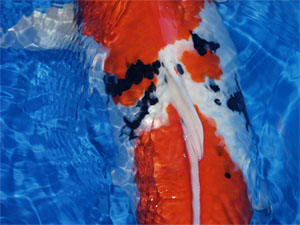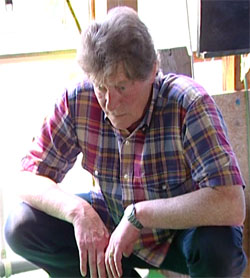In real truth, there are only a handful of Go-Sanke of this magnitude in all of Japan at any one given point of time.
In view of the above, and in view of the fact that some Koi have great potential in smaller sizes to become future champions of significant monetary value – it is therefore easy to understand why many collectors, breeders and dealers scour the breeding farms to try to find these specimens from the breeder’s Tategoi when they are still young Koi and before they are Champions. A few exceed expectations after a period of time whilst many others do not – that also is Tategoi – or the buying of a dream!
Most Japanese breeders make the final selection of their tosai Tategoi during April or May each year after all their stocks have been kept indoors since the previous October. These are generally tosai (Koi born last June and now between 12cms – 20cms); Nissai (Koi born the June before and now between 30cms – 45cms) and some Sansai (Koi born the June before that and now 45cms – 55cms). The relatively few Tategoi selected will be placed in the mud ponds in late May or early June and the remainder, known as Tateshita (Ta-tay-shta – no longer Tategoi) will be sold in volume to brokers or exporters. The breeder can tell at this time the sex of the Nissai & Sansai and will only select females to grow in his mud ponds, however he cannot even guess as to the sex of the Tosai. For these he selects by skin, shape & good distribution of red pigment, these Tategoi will be fed until October when they will be harvested at around 35cms – 45cms and sex can be accurately determined. It is interesting to note that around 80% of the Tosai Tategoi selected in April and showing good distribution of red pigmentation or good potential pattern turn out to be male at the October harvest and, as such, are no longer Tategoi and are sold cheaply! Collectors who buy tosai Tategoi should always be aware of this point.
Describing Tategoi and what to look for is extremely difficult, cheaper examples of Tategoi come from non-patterned varieties such as Chagoi; Benigoi; Kigoi; Yamabuki; Purachina; Matsuba and suchlike where shape; volume; unblemished pigmentation and the reputation of the breeder all play a part in the selection. More difficult to find, and more expensive pro-rata, are patterned varieties such as Kikusui; Hariwake; Koromo; Bekko; Asagi; Shusui; Goshiki; Ochibashigure; Kumonryu; Kujaku; Kin Showa; Tancho and so on where pattern plays an extra part to the former requirements.
As far as Go-Sanke varieties are concerned I have mentioned requirements of a finished champion earlier; how to find these as young Tategoi is bordering on the impossible. If I were asked to find a good Go-Sanke Tategoi for a customer I would start with breeders who already have good reputations within the Koi industry. Names spring to mind like Isawa Sakai; Dainichi; Hiroshima Sakai; Momotaro; Yamamatsu; Miyoshike; Shintaro; Torazo; Hirasawa; Hasegawa; Igarashi Kazuto and several others. Next I would point to one or two Koi and ask them to show me them and spend hours just looking at them without any mention of prices. At two year to three year sizes there is not a great deal to go on apart from the previous important requirements as, generally – but not always, these Koi have not been fed any colour enhancing food yet. This means one has to ‘imagine’, by half-closing one’s eyes, how the pigmentation and pattern will develop in, say, four to five years time. The real quality of a particular example, however, can be seen at this size by two simple measures, namely the overall skin of the Koi and the very important distribution and ‘uniqueness’ of beni, in Kohaku, Sanke and Showa varieties
 In general terms it is easier to purchase excellent Tategoi in one to two year sizes which will have the potential to take important awards in shows when they are three to four years old. Alas, these rarely continue to take important awards in larger sizes. It is also relatively easy to purchase excellent Tategoi in four & five year sizes which can go on to take important awards in shows when they are seven to eight years or older. In view of this, the keeper should plan before purchase the size groupings he/she is aiming at. However it is almost impossible to select a one-year old Tategoi that will, after a further ten years or so, go on to take important prizes in jumbo sizes!
In general terms it is easier to purchase excellent Tategoi in one to two year sizes which will have the potential to take important awards in shows when they are three to four years old. Alas, these rarely continue to take important awards in larger sizes. It is also relatively easy to purchase excellent Tategoi in four & five year sizes which can go on to take important awards in shows when they are seven to eight years or older. In view of this, the keeper should plan before purchase the size groupings he/she is aiming at. However it is almost impossible to select a one-year old Tategoi that will, after a further ten years or so, go on to take important prizes in jumbo sizes!
1. In female Go-Sanke varieties between one to two years old one must first closely inspect the skin or ‘ground’ of the Koi. ‘Pure white’ is seldom apparent in these sizes, look instead for a ‘silkiness’ or shine to the skin. If the ground takes on a ‘dull, lack-lustre’ effect then try to look for another example.
2. After selecting an example with this type of skin next check the estimated potential overall pattern after maximum growth has been achieved – a crystal ball is handy here! (see item 6 below)
3. Shape and length at a relatively young age can indicate, but only ‘indicate’, potential growth if the Koi is kept in optimum conditions. A ‘long’ head on a slender and ‘long in size for its age’ female Koi bred by a reputable breeder is well-worth studying whereas those with shorter heads in ratio to the length of the body should be discounted as ever really reaching jumbo size. Body shape actually rarely comes into the forefront with Tategoi of one to two years of age as this becomes far more apparent as the Koi matures. However, do make sure there are no deformities at all as far as the body and fins are concerned.
4. The pigmentation of the beni in smaller sizes is confusing but the texture/quality is easier to understand. Most of the famous producers rarely feed colour-enhancing foods to their Tategoi until they are three years old. As a result, high class Tategoi, in smaller sizes, can have a ‘yellow-red’ pigmentation which defuses the myths in earlier books which advised the buyer to ‘look for the deepest red possible’. The highest grade of beni actually comes from ‘orange-red’ and not ‘purple-red’ which, in small sizes, may look very attractive but will develop ‘windows’ of white areas in later years. High class beni, in smaller sizes of Nishikigoi, will have an orange-red or yellow-red pigmentation but the texture or quality of the beni will remain constant throughout the entire pattern of the Koi.
5. Check next the rear/trailing edge of each red pattern as these will move backwards towards the direction of the head as the Koi matures and the rear edge of the pattern stabilises. If a ‘scallop effect’ termed as ‘maruzome’ can be achieved on the rear edges, after stabilisation in later years, so much the better.
6. As to the pattern itself, make sure the distribution of beni, in smaller sizes, runs throughout the body of the Koi. There should be no large areas where the beni is absent – i.e. no beni from dorsal area to tail or no beni on the head area. Look at past champion Koi where this is a good rule of thumb to determine patterns that have been favoured by the Japanese Judges.
 Incidentally, many Koi judges often try to impress upon their listeners that ‘pattern is not really so important when evaluating a Koi entered into a show’. In my take on it all, pattern is just about the most important single thing I look at before taking into consideration all the other aspects that go towards making ‘the whole’. This is also the case I have seen whilst watching the breeders make their selections.
Incidentally, many Koi judges often try to impress upon their listeners that ‘pattern is not really so important when evaluating a Koi entered into a show’. In my take on it all, pattern is just about the most important single thing I look at before taking into consideration all the other aspects that go towards making ‘the whole’. This is also the case I have seen whilst watching the breeders make their selections.
7. Another confusing matter is when the Tategoi becomes larger or one simply wishes to purchase larger-sized Tategoi, is that body shape & volume/size becomes far more important than the vital ‘pattern’ requirement in smaller sizes of Koi up to four years old.
8. Also a ‘seemingly-minor’ point should be taken into account when entering such Koi into a competition. In Japanese shows, size groups are in 5cms increments, a Koi measuring 40.5cms would compete with other Koi in ‘45cms Size’, which includes Koi up to 44.9cms. 4.4cms may seem to be hardly worth mentioning when, in real terms, this can be significant as far as volume and body shape are concerned during judging. The same 40.5cms Koi could well be 49.9cms after one year and it may well be better to wait one more year rather than to enter it into this year’s show.



